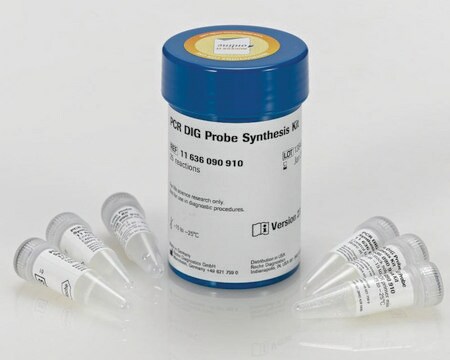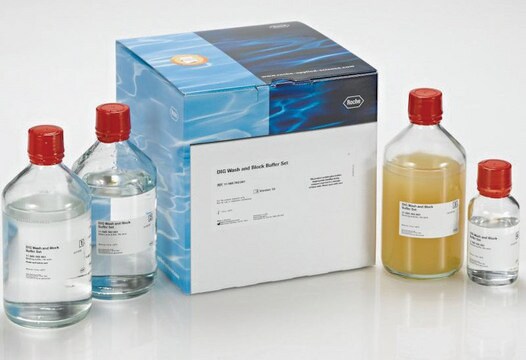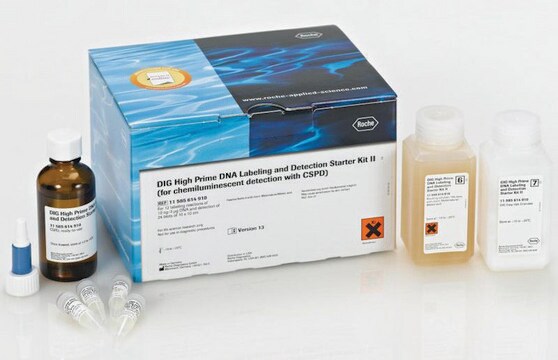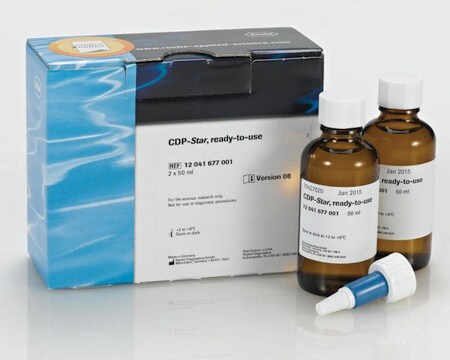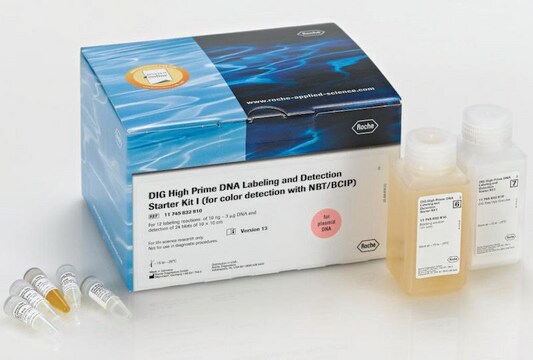12039672910
Roche
DIG Northern Starter Kit
suitable for Northern blotting, sufficient for 10 labeling reactions
Synonym(s):
DIG system, Northern blot
About This Item
Recommended Products
usage
sufficient for 10 blots (blots of 10 x 10 cm2)
sufficient for 10 labeling reactions
Quality Level
manufacturer/tradename
Roche
greener alternative product characteristics
Designing Safer Chemicals
Learn more about the Principles of Green Chemistry.
sustainability
Greener Alternative Product
parameter
68 °C optimum reaction temp.
technique(s)
Northern blotting: suitable
greener alternative category
storage temp.
−20°C
General description
Application
Packaging
1 kit for up to 10 labeling reactions and detection of 10 blots, blots of 10×10cm2, reactions of μg DNA, yielding approx. 20μg labeled RNA, each
Preparation Note
Assay Time: 9 hours 30 minutes
Sample Materials:
- Linearized plasmid, including the appropriate RNA polymerase promoter sequence (SP6, T3, T7).
- Specially prepared PCR productWorking solution: Note: Use sterile, RNase-free solutions and equipment.
Note: The length of the region to be transcribed should be in the range of 200 to 1,000 bp. To avoid RNase contamination the DNA must be phenolized.
Other Notes
Kit Components Only
- Labeling Mix 5x concentrated
- Transcription Buffer 5x concentrated
- SP6 RNA Polymerase 20 U/μl
- T7 RNA Polymerase 20 U/μl
- T3 RNA Polymerase 20 U/μl
- Anti-Digoxigenin-AP antibody, Fab fragments 750 U/ml
- DNase I, RNase free 10 U/μl
- CDP-Star ready-to-use
- Actin RNA Probe, DIG-labeled Antisense Probe, length 588 bases 10 ng/μl
- DIG Easy Hyb Granules
- Blocking Solution 10x concentrated
Signal Word
Danger
Hazard Statements
Precautionary Statements
Storage Class Code
12 - Non Combustible Liquids
WGK
WGK 3
Flash Point(F)
does not flash
Flash Point(C)
does not flash
Certificates of Analysis (COA)
Search for Certificates of Analysis (COA) by entering the products Lot/Batch Number. Lot and Batch Numbers can be found on a product’s label following the words ‘Lot’ or ‘Batch’.
Already Own This Product?
Find documentation for the products that you have recently purchased in the Document Library.
Customers Also Viewed
Articles
Digoxigenin (DIG) labeling methods and kits for DNA and RNA DIG probes, random primed DNA labeling, nick translation labeling, 5’ and 3’ oligonucleotide end-labeling.
Protocols
DIG Northern Starter Kit Protocol & Troubleshooting
Our team of scientists has experience in all areas of research including Life Science, Material Science, Chemical Synthesis, Chromatography, Analytical and many others.
Contact Technical Service